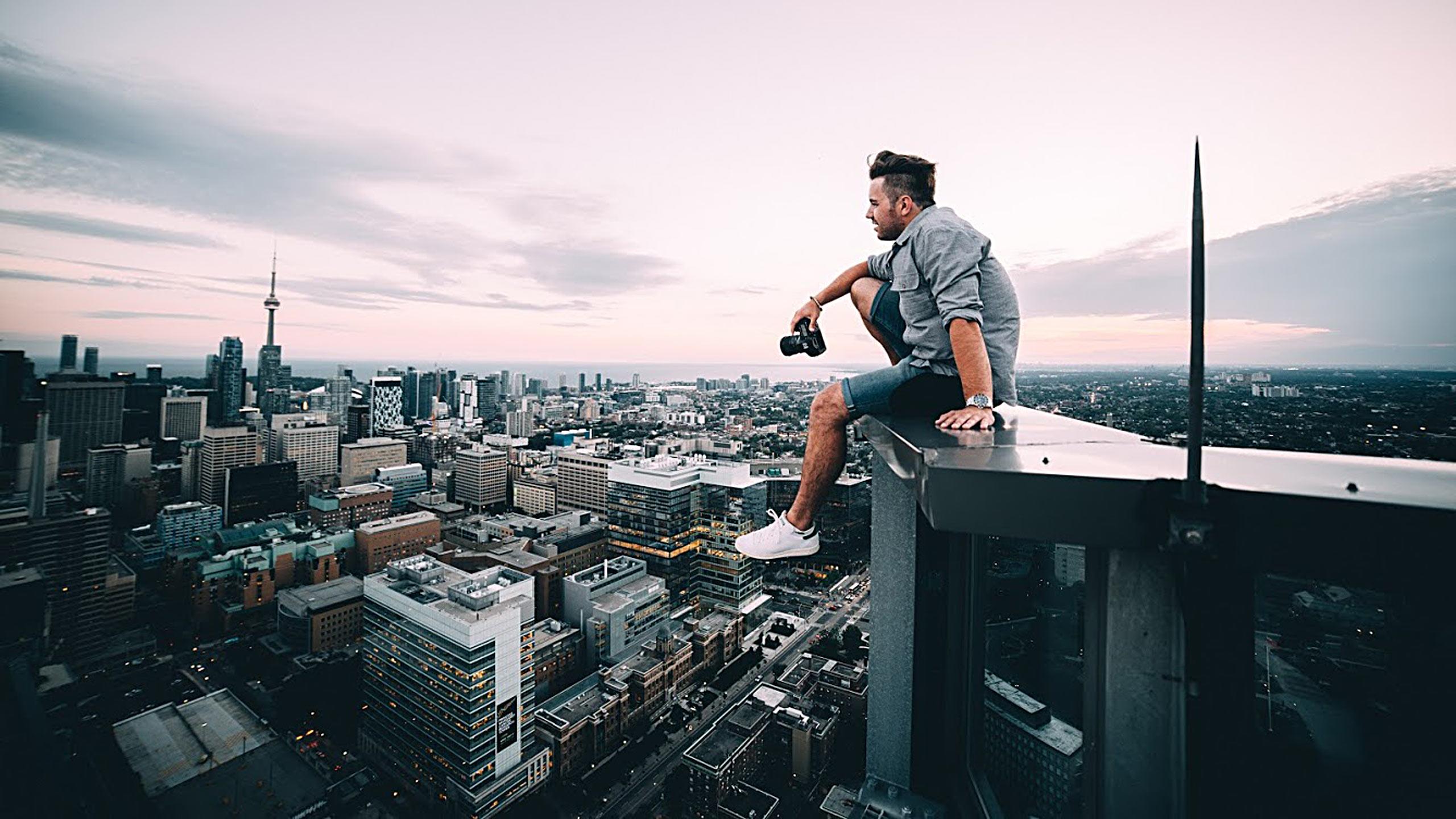Be sure to vote for your favourite photographer from our special photography issue here!
By Karoun Chahinian
The first time Justin Abernethy stepped foot on a rooftop was in April 2016. Accompanied by a group of fellow Instagram photographers, he climbed the stairs of the building near Yonge and Wellesley streets. He was afraid of heights, so he stayed away from the edge—he couldn’t even get himself to look down.
Since then, he has snuck onto nearly 20 rooftops, often in the middle of the night.
“The height thing isn’t so much of a fear anymore,” the fourth-year Ryerson photography student said. “Now, I can sit on the edge and it’s not the scariest thing for me because I’m comfortable … How many people in the city of Toronto can be driving around and be able to say, ‘I’ve been on that building before?’”
Abernethy, 21, fell in love with taking photos of Toronto while working for the private garbage removal company, 1-800-Got-Junk?.
Whether he was picking up an old couch in Brampton or driving across the city to get a piano in the Beaches, Abernethy slowly got to know every neighbourhood in Toronto. One day in June, surrounded by rain and fog near the city dump at Polson Pier, he stood focused on the city skyline, ignoring the lingering smell of garbage and the high-pitched squeals of rats around him. He stopped to take a photo on his iPhone. From there, he transformed his personal Instagram into a street photography account—which has since gained over 4,000 followers.
Abernethy slowly began to appreciate the architecture and the lines that certain city buildings created. “There’s no other atmosphere, nothing that compares to it,” he said. “Toronto is an amazing place, I couldn’t have asked for anywhere better to start my street photography.”
[ngg_images source=”galleries” container_ids=”303″ display_type=”photocrati-nextgen_basic_slideshow” gallery_width=”678″ gallery_height=”452″ cycle_effect=”fade” cycle_interval=”5″ show_thumbnail_link=”0″ thumbnail_link_text=”[Show picture list]” order_by=”sortorder” order_direction=”ASC” returns=”included” maximum_entity_count=”500″]Rooftopping is a simple process. Abernethy and his friends usually wait outside their targeted building and swiftly follow a resident with a key fob to get inside. To stay under the radar, they leave their cameras in their backpacks and take the elevator to highest floor.
Then they find a stairwell to the roof, where they’re met with a door. Sometimes it’s unlocked, sometimes they need to pick it open. Throughout his photography career, Abernethy—like many other Toronto rooftoppers—has learned how to pick different types of locks.
“Try [to] be in and out within 10 to 15 minutes because if someone sees you from another roof, security will get called,” he said. “Get your pictures quickly.”
Despite his quick skills, Abernethy and his friends have been caught before. Once, they were ordered to delete all of their photos immediately and were banned from the building they were on. He says he plays stupid whenever he gets confronted by a security guard—claiming that the Odoor was open, or that everyone had access to the roof.
One of the bigger obstacles for rooftop photographers, according to Abernethy, are the other rooftoppers who break locks on doors and tag buildings with spray paint. “Some people will go on roofs by breaking the lock and will spend two or three hours up there. That makes everyone else look bad,” he said, adding that above all else, staying safe is important.
Through Instagram, Abernethy has collaborated with dozens of photographers—many of whom are part of his usual shooting group—and has received several job inquiries from small startups.
Abernethy finds the volume of rooftoppers and their success on social media to be inspiring, rather than intimidating.
“The Toronto community is so good to each other. Everyone just feeds off each other’s energy and vibes and works together to get where they need to be,” he said.
While Abernethy is known for his street photography on Instagram, his goal is to become a fashion photographer for a large-scale magazine, or to work on company campaigns.
“I feel like you’ll always progress as a photographer more with a following,” he said. “I’m sort of marketing myself as [a street] photographer because that’s where I feel I need to go to get my name up there. But fashion is definitely where my heart is at the end of the day.”
For financial support, he’s taken on many part-time jobs, including assisting professional photographers, as well as paid shoots.
The thing that provoked his interest in fashion was his time spent as a model for the Elmer Olsen modeling agency. After one particular shoot, he was observing the photographer edit one of his photos and saw how artistically unique and “high-fashion” the shot was. He was intrigued by the drama and artistry behind fashion photography, and thought that he could do the same thing.
Abernethy became interested in rooftopping only recently, but his interest in photography dates back to Grade 10, where he took photos of his friends during their lunch breaks at Etobicoke Collegiate Institute. His first ever camera purchase was a Nikon D60.
He went on to take photography elective courses in highschool, where he had access to the school’s dark room. When his father gifted him his Pentax film camera from the 1980s, he started developing his own photos. He became enamored with the craft entirely and one day, while browsing through his personal collection of printed film shots, decided to pursue it at Ryerson.
“Out of any other form of art, photography was the one that stood out. What really impressed me was that one picture could tell a story and you wouldn’t really need context,” he said.
“If I didn’t have photography in my life, I don’t know where I’d be,” he said. “Every photo you take has your own sort of perspective on it. There’s something about it that’s you.”











Leave a Reply